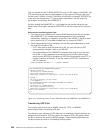In the preceding example, if the target file does not exist, a file with a CCSID of
273 is created on the receiving system. When the target file already exists, the
data is converted from CCSID 273 to the CCSID of the target file.
v When starting the FTP client, message TCP3C14: Unable to convert data from
CCSID &1; to CCSID &2, may be displayed. This occurs if no character
conversion is available between the EBCDIC CCSID specified by your job and
the ASCII CCSID specified for the this FTP session. You can change the ASCII
CCSID by specifying a value for the coded character set identifier parameter of
the STRTCPFTP CL command. CCSID 850, which contains the IBM Personal
Computer Latin-1 coded character set, is an ASCII CCSID for which character
conversions are available to all valid job CCSID values.
v When using FTP in ASCII mode between two EBCDIC systems, the data on the
system sending the file is converted from its stored EBCDIC code page to ASCII,
and then from ASCII to the EBCDIC code page of the receiving system. Usually
this does not present a problem because the 7-bit ASCII code page used by the
two systems is the same unless the EBCDIC characters on the sending system
are not defined in the ASCII code page. Also, some characters in the ASCII code
page may be mapped differently between the two different EBCDIC code pages.
This might occur if some of the ASCII characters are
variant
(the character
occupies a different hexadecimal code point in an EBCDIC code page). The
variant character may be interpreted differently on the receiving system if the
EBCDIC code page is different from that of the system sending the file.
Effects of Job Wait Time on FTP
FTP is dependent on the wait time of the job issuing an FTP request. Use option 3
(Display job run attributes, if active) from the Work with Job (WRKJOB) menu to
view the value of the job wait time. To increase the value of the job wait time, use
the Change Job (CHGJOB) command.
FTP Client Considerations
This section contains additional detailed information that is pertinent to the AS/400
FTP client including:
v File client naming considerations
v File structure and path name
v Mapping tables
v Server time-out
v Using server subcommands
FTP Client File Naming
When using the PUT and GET subcommands without specifying both the local and
remote file name, a name is chosen for you. This name may not be the name you
expect or want.
For example, you could type the following subcommand to get your PROFILE
EXEC (file name, file type) from an IBM VM (Virtual Machine) system:
GET PROFILE.EXEC
VM sends the file to your AS/400 system and gives the file a name of PROFILE
and a member name of EXEC. However, you may prefer that the file name be
EXEC and the member name be PROFILE so that you could later add more
members to this “exec” file.
266 OS/400 TCP/IP Configuration and Reference V4R4


















